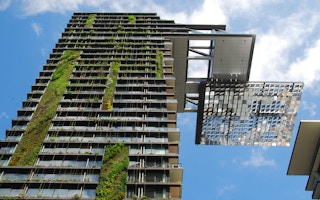Ever wonder what’s the most cost-effective solution to cool the temperature? Simple. Planting more trees or incorporating more vegetation/plants in city design. It puts a new slant on the idea of the “urban jungle.”
Climate change is one of the most serious risks to urban life. Our cities are heating up. The dangers of the urban heat island — when concrete buildings, asphalt roads and other urban infrastructure absorb and re-emit solar radiation more than natural landscapes — are well documented, increasing temperatures in built-up areas which can increase the risk of heat-related illnesses.
Poorly planned city development increases this risk. According to the Secretariat of the Convention on Biological Diversity, only 40 per cent of the urban areas expected to exist by 2030 exist, meaning significant further urban development will occur over the next decade.
“Nature-based solutions” refer to a wide range of strategies with the potential to curb greenhouse gas emissions. They can improve an ecosystem’s capacity to absorb carbon dioxide or reverse degradation to the point where an ecosystem once again becomes a “net sink” of carbon (storing more carbon than it emits).
Of all the methods for reducing the heat island effect, those involving plants have proven to be the most successful. There is still disagreement in the scientific community over how much green space people need and whether current systems adequately address this issue, despite the importance of urban green space to the layout and impact of today’s dense urban centres. The World Health Organization advocates for easy access to green space, suggesting everyone lives no more than 300 metres from a green area covering at least half a hectare.
Vegetation can mitigate the effects of extreme climate, reduce energy use, and improve people’s physical and physiological well-being, all of which go a long way towards making urban living more bearable.
“
Using plants to moderate the heat and reduce dependency on artificial cooling can be the seed of a solution to the dangers of rapidly heating cities.
In tropical regions, buildings exposed to more sunlight increase energy demand. Using plants for shade can reduce solar radiation, cool the building and improve energy efficiency. While trees have been planted to shade homes for generations, there has been substantial innovation in the application strategy in recent years.
A tree canopy
Tree canopies cool the ground below by blocking sunlight and controlling how much heat a building radiates into the environment. For tropical cities, Ceylon Ironwood trees have dense branching, and high leaf coverage provides excellent shading. Due to the shade, less absorbed heat is radiated to the air, encouraging evapotranspiration, reducing the surrounding temperature and increasing people’s thermal comfort. Indoor and outdoor temperatures can be lowered by more than 3 degrees when plants are used to modify the microclimate.
The shading performance of each species is different, resulting in varying scales of effectiveness on microclimate alterations, making living walls with climbers and creepers a suitable alternative when there is no space for trees.
Living walls
A “living wall” is a system that irrigates and sustains a vertical garden. Living walls can influence the microclimate by reducing surrounding temperature and may also be part of a water treatment system.
Vegetation incorporated into a building’s exterior has two purposes: it lowers the heat transferred inside and improves the building’s look. A green facade is one in which plants such as vines and creepers are grown directly on the building’s exterior, while green walls are one in which a system is used to cultivate different species of plants along the wall surfaces.
Green facades and green walls are two common living wall systems that increase a building’s energy efficiency. Green facades have vegetation either planted directly in the ground or planters climbing onto building surfaces or light framework, and green walls have vegetation growing on a different system then attached to the wall instead of being planted directly. A green wall uses materials and innovative technology to cultivate various plants along the wall surfaces. A continuous green wall, also known as a “vertical garden,” usually instils lightweight and permeable frames where plants would be planted individually.
Climbing plants like Double Rangoon for a green façade are essential for optimal performance and a sustainable living environment. Climbers like the Yellow Trumpet vines create a more pleasant microclimate, while the Curtain Creeper lowers the surrounding temperature and cleanses the air.
Growing food
Urban farming is not as cutting edge as you think; people have been doing so for centuries at Machu Picchu and the ancient Hanging Gardens of Babylon. People all across the world have always had gardens in their homes. They shaped their surroundings to enhance their quality of life. Today’s urban garden integration has progressed, emphasising their ability to reduce greenhouse emissions and greening cities.
Green infrastructure could help the city coordinate the revitalisation of unused, abandoned, or underutilised spaces. Small-scale farming in these areas might offer urban residents food while reducing carbon emissions. Spaces between buildings (interstices) in the city can be used for urban farming, which also helps modify the city’s microclimate. Rooftops, balconies, and vacant lots are all excellent places to start an urban farm.
The presence of vegetation significantly influences a building’s microclimate. It has been demonstrated that vegetation can reduce temperatures by 1.32 to 5 degrees Celsius compared to a hard surface area. Because of evapotranspiration, vegetation can lower local temperatures, hence altering microclimates.
Urban greening can mitigate the urban heat island effect, especially in the spaces between buildings. Using plants to moderate the heat and reduce dependency on artificial cooling can be the seed of a solution to the dangers of rapidly heating cities.
Ts Dr Tamil Salvi Mari is a senior lecturer in architecture at Taylor’s University, Malaysia. Salvi’s research area revolves around investigating humane design — the interaction between humans, the built environment and the natural environment, focusing on current societal and environmental needs.
Originally published under Creative Commons by 360info™.











